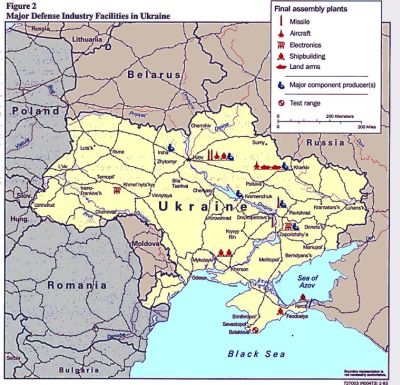Caught Between Two Worlds – Ukraine’s Defense Industry
Between Two Worlds
When was the last time you hurried down to Best Buy to pick up the latest “state-of-the-art†electronic device – from Ukraine! Or, how often do you cruise the pages of Car & Driver magazine just to get the inside skinny on the newest models of Ukrainian automobiles? How about passing up a Panasonic flat-screen TV for one manufactured in Ukraine? Yeah, fat chance! Yet, if you attend any of the gun shows that attract collectors, shooting enthusiasts and sportsmen across the U.S., you’ll find tables loaded with “best-sellers†imported from Ukraine and other former Soviet republics.
For over a half-century the USSR produced arms and munitions at the expense of civilian commodities, and all of the former Soviet republics have huge stockpiles of weapons (for example, USSR arms factories produced 80-100 million AK-47 assault rifles, flooded the Third World with them, and made it the poor man’s weapon of choice – it remains the principal small arm for Iraq’s new army). It was probably only natural that those looking for quick cash turned to exporting these no longer needed armaments. Yet, this is not an inexhaustible source (nor will the demand remain high, once the weapons’ ‘exotic’ factor has worn off). This massive sell off, which often merely lined the pockets of Ukrainian private “entrepreneurs†(civilian and military) operating for their own gain, represents Ukrainian defense industry’s past — the “bad old days†characterized by the still-lingering Soviet era legacy of bloated, suffocating bureaucracy and cronyism from the corrupt, command-directed economy.
{default}
Portuguese and American workers tend to the Antonov An-225 Mriya, or “Dream,” April 28 on the flightline here. The aircraft landed here to refuel and get serviced. Currently the world’s largest aircraft, the An-225 was designed mainly to transport the Russian space shuttle and its components from a service area to a launch site.
Now, however, imagine that you need to move a 100-ton railroad locomotive from St. Louis to Bahrain – and you need to fly it there. The only cargo airline in the world that can do that for you is Antonov Airlines, located in Kiev. The monstrous Antonov AN – 225 cargo plane is the largest airplane in the world, a true technological marvel that was designed and manufactured in Ukraine. Antonov Airlines’ AN – 225 (and the slightly smaller AN – 124) provide a unique heavy-lift, outsized cargo service that can move anything from hundreds of tons of humanitarian assistance supplies to massive construction equipment and locomotives anywhere in the world. The U.S. armed forces has even leased the huge cargo carrier to move supplies to the Persian Gulf (beginning in 2001). Although it might technically be classified as another legacy of Ukraine’s Soviet era (it was completed in 1989, shortly before the USSR collapsed and subsequent Ukrainian independence), it represents the future of Ukraine’s defense industry. Antonov Airlines’ heavy lift aircraft fleet stands as a tantalizing example of the, as yet, untapped potential of Ukraine’s defense industry.

Major defense industry facilities in the Ukraine.
Ukraine’s defense industry remains firmly stuck between two worlds – one characterized by the lingering legacy of the Soviet Union’s command-directed economy, beset by corruption, cronyism and the lack of innovation; and the other manifested in the promise held out by the market economy of western Europe and the United States that rewards initiative and can lead to genuine progress. When Ukraine gained its independence with the fall of the Soviet Union in 1991, its previous status as having one of the most robust agricultural-industrial bases of all of the USSR’s former republics (including Russia) augured well for the creation of a solid defense industry that could provide for the country’s military requirements, contribute to the overall growth of Ukraine’s economy, and position the country’s defense industries to successfully compete in world markets. Yet, Ukraine’s political leadership has not proven able to capitalize on this potential.
Burden of Great Potential
Ukraine’s defense industrial complex is the most advanced and developed branch of the state sector of the country’s economy. It includes about 85 scientific organizations that are specialized in the development of arms and military equipment for various usages. The air and space complex, alone, consists of 18 design bureaus and 64 factories; and in the area of naval ships and armaments the country has 15 research and development (R&D) labs, 40 design bureaus and 67 manufacturing plants. Rockets, missiles and ammunition are developed and built at 6 design bureaus and 28 plants. Similar complexes exist for design and manufacture of small arms, armor equipment, electronics (such as military communications, intelligence and radio-electronic warfare systems), and combat engineer equipment.
Ukrainian defense industry was fully integrated into the economy of the Soviet Union and the country’s bureaus, factories and laboratories were essential components of the USSR’s defense industry. Kharkov, the second largest city in Ukraine (and home to the greatest concentration of defense industry in the country with over 250 industrial enterprises) was the third-largest industrial city in the USSR prior to the Soviet collapse. Ukraine possesses significant port and shipbuilding facilities, an extensive transportation network, a solid machinery base and a skilled work force. Forecasters predicted that when Ukraine achieved its independence in 1991 its defense industry had the best prospects of any of the former Soviet republics for economic development by attracting investors. The reality, however, proved significantly different.
Newly-independent Ukraine experienced serious inflation, privatization nearly ceased, wages fell catastrophically, and economic output declined sharply. By 2000, the state still owned nearly 60-percent of all incorporated companies. Some efforts at reform have been made, and these have led to more economic growth and subsequent improvement in quality of life for the population as a whole. Yet, real progress for Ukraine’s defense industry ultimately depends upon taking on a much bigger challenge.
[continued on next page]

